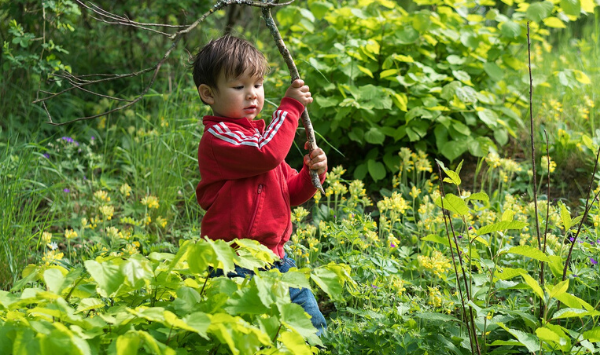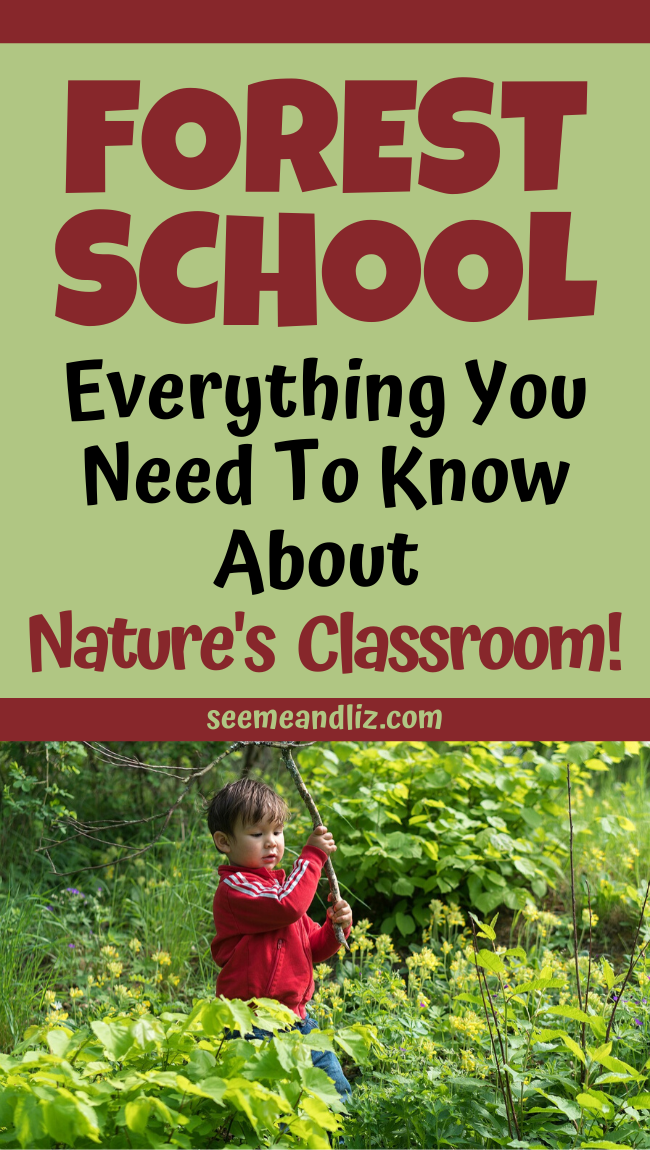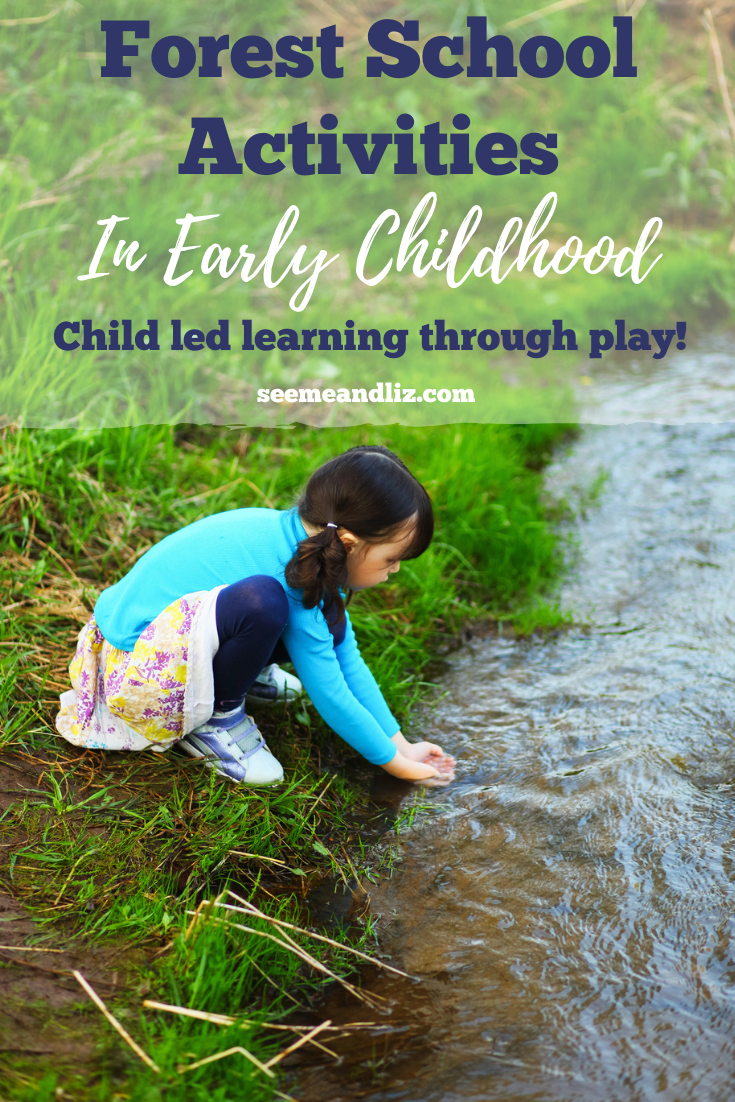*Updated February 2022*
Children thrive outside but every year, studies show that less and less time is spent outdoors by children.
This is where forest schools can come into play!
Have you heard of them before?
If not, below is a brief history of the concept followed by examples of some forest school activities for preschoolers and kindergartners.
What Is A Forest School?
A forest school is a non-traditional school in which children spend 80-90% of their time outdoors.
According to Liz O’Brien and Richard Murray (2008 – Forest School Research Summary), a forest school can be been defined as “an inspirational process that offers children, young people and adults regular opportunities to achieve and develop confidence through hands-on learning in a woodland environment”.
When Did Forest Schools Begin?
This type of schooling first started during the 1950’s in Scandinavia.
The benefits of an outdoor based curriculum became clear and forest schools starting popping up all over the UK soon after.
In 2008, Canada’s first forest school opened near Ottawa, ON.
Now there are many forest school programs in North America.
Some of these programs are only for the early years (preschool – kindergarten) while others are for older students as well.
This article will focus on forest school activities for preschool and kindergarten aged children.
What Happens In A Forest School In A Child’s Early Years?
*This article may contain affiliate links*
Place and Play Based Education
Place based education, often referred to as experiential education, is at the root of forest schools.
This allows children to develop a close bond with their educators, peers and their environment.
Fields, forests, streams, tundras, meadows, etc, can all serve as a classroom and they are each filled with unique learning experiences.
Just like children get to know their classroom in traditional schools, children get to intimately know their environment at forest school!
The curriculum is based around the environment.
The teacher does not need to make seasonal changes to the classroom as these happen naturally in a forest school (depending on where you live and how many distinctive seasons there are).
Play is a crucial part of a child’s emotional and cognitive development.
When children are learning through play they have the opportunity to develop their own ideas, express their needs and build relationships with others.
Experiential and play based learning are at the core of forest schools.
Children can play a game of hide and seek, create elaborate stories, or spin around through the green space while at forest school.
The days do involve some structure and there is a curriculum in place but it is child led.
A typical day at forest school begins with an opening circle for preschoolers and kindergartners.
The ratio of adults to children is usually higher at forest school than at a traditional school.
Children and their instructors gather around in a circle and sit on tree stumps or on the grass (depending on the where the forest school is located). Songs are sung, ideas are shared and the day is planned together.
After this, the children and adults will freely explore the environment and talk about things they see, for example, leaves changing color, baby birds hatching, new buds on trees, etc.
Following the exploration part of the day will usually be lunch, which is either eaten outside or in a small building (most forest schools have some form of building that the students can go into for a small portion of the day).
Children are encouraged to write/draw in journals.
Most buildings will have items such as magnifying glasses and microscopes for the children to examine some items found in nature.
I want to point out that Aimie Stilling of The NaturePlay Documentary sent me an email after reading this article to let me know that “writing/drawing in journals” never happens in Scandinavian Forest Schools (where the concept originated).
Aimie stated that children are in “pure nature play” until the age of 7, with adults modeling appropriate social behavior.
Experimenting with sawing, knife work, fire work, wild foraging and fort building are encouraged under supervision.
But despite this, these children have some of the highest (academic) test scores in the world when they are older.
Subjects such as science and math can easily be taught at forest school and the setting is very natural.
For example, in Kindergarten, students will learn about sinking and floating as part of the science unit.
Little Sammy who attends forest school throws a rock into a stream and notices that it sinks. He then throws in a twig, but this time it floats.
Other children gather around and throw in other objects that they find lying on the ground to see whether or not they will sink or float. The instructor can then discuss why some things sink and others float.
As you can see in the above example, children at forest school are having fun. To them this is not learning, it is being a child.
This is exactly how a child learns best.
Through experiences and inquisition!
Most forest schools will end the day with a closing circle in which songs are sung and the days activities will be discussed.
Is Forest School Right For Your Child?
Unfortunately I cannot answer this.
My children did not go to forest school as I learned about this concept once they had started elementary school.
I like the idea of it for preschoolers and kindergarten students.
I don’t know enough about it to comment on what my thoughts are on this type of education for school aged children.
Forest schools can be a good alternative for children who do not do well in a traditional school setting as it truly is child led learning.
Not every 4 and 5 year old can sit and listen while enclosed in 4 walls; in fact most cannot and this is totally developmentally appropriate.
Children want to be and should be exploring their environments.
In fact, children need to partake in risky play activities as part of a healthy childhood!
If you are interested in sending your child to a forest school a quick google search for “forest school” + your location will bring up schools in your area.
There are several school boards in North America that are making the switch to play based learning for kindergarten students.
The administrators at many traditional schools are starting to realize that play based and child led learning is the way to go for 4 and 5 year old’s.
It will take a while for these Kindergarten classrooms to be truly play based which means they are adult guided and child led, however, it is a positive step in the right direction!
Forest schools may not be for everyone and if this is the case for you and your child, you can still make sure to encourage plenty of outdoor, child directed play!
Will Your Child Go To Forest School?
What do you think of forest school activities in a child’s early years?
Do you believe that children really do learn through play?
As I mentioned above, forest school will not be ideal for all families, however I do believe that these types of activities can and should be incorporated into a child’s everyday life.
Nature provides so many learning experiences that we should all be using to our advantage and best of all, you don’t have to pay to go outside to play and learn!
Please share your thoughts in the comments below!






I’d never heard about forest schools before reading your post. I don’t have kids myself but spend a lot of time with my young nephews and nieces. I have noticed that the ones who are encouraged to spend a lot of time outside are much more sociable and curious about the world compared to the ones that stay indoors and get too much screen time. I’m sure forest school activities in a child’s early years would most likely have the same effect.
If I look back at my early years, I looked forward to exploring the forest with my buddies and its always stayed with me. Forest schools sound like a really good idea.My only concern is here in the UK we have a lot of bad weather. There’s plenty of beautiful forests but how would a forest school work with all the rain and the cold?
I was wondering about the changes in season as well when kids go to forest schools. The UK does seem to have the largest amount of forest schools so I’m sure they have figured something out with regards to the weather changes. Perhaps they aren’t outside quite as much on really cold days as most forest schools have a building that the students can go into.
I really like the exploration and play based learning that forest school activities provide when compared with traditional schooling.
Tanya and Jay – the forest school my son attended in Guelph (Canada) happens outdoor in rain/sun/winter/summer. There is a leanto they can use for shelter if they need but the one my son attended to did not have any type of traditional building. His learning experience was completely outdoors. They cooked soup over the fire for lunch, parents packed snacks and water. Children were encouraged to use the same equipment/tools adults use to start fires/cut wood etc. which would have most parents a little fearful.
I truly believe in this type of education and find myself more and more aligning with a more homeschooling/unlearning type of experience.
Great introductory article.
Kirsten
Thanks for your comment Kirsten! I am happy to hear your son had a great experience at Forest School. I think that this type of education is becoming more popular and therefore will become more accessible for many families!
Oh this sounds great! I would love it if something like this was available in South Africa for my kids (2 yrs old and 4 yrs old).
I chose the playschool my children are in because they do outdoor things like gardening and feeding animals. They have a lovely outside area with animals. However most activities are indoors.
My kids love nothing more than being outside and doing things like hunting for caterpillars.
Great article and I will be searching to see if there are any schools like this in South Africa.
It sounds like your kids are going to a great playschool if they have animals right outside their door. My kids also love searching for caterpillars. They actually found one last night and put it in their “bug catcher”. I think it may have ended up in our garage. I better go and set it free before it’s too late.
Let me know if you end up finding a Forest School in your area.